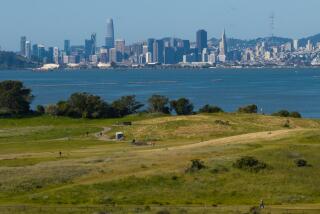Bird Nests, Canal Rules Stall San Onofre Reactor’s Trek
- Share via
Southern California Edison officials acknowledged Thursday they face an array of obstacles that will probably stall controversial plans to move a 950-ton decommissioned reactor from the San Onofre nuclear power plant to the East Coast for disposal.
Last week Edison officials said they had hoped to ship the reactor to a South Carolina nuclear waste site starting in March, but problems at each stage of the proposed journey now make that unlikely, Edison spokesman Ray Golden said.
The Panama Canal Authority has denied Southern California Edison permission to move the reactor through the waterway, officials said Thursday. The reactor was to be loaded onto a barge at the Camp Pendleton Marine base next month and shipped to a burial site in Barnwell County, S.C.
Other obstacles have dogged Southern California Edison’s attempt to move the radioactive reactor, from disputes with the California Department of Transportation and rail line officials to opposition from environmentalists.
“This reactor is likely to become the garbage barge of California, wanted by no one and adrift at sea,” said Mark Massara, coastal programs director of the Sierra Club of California.
Canal Authority officials said they denied San Onofre officials permission to travel through the passage in December. The maximum weight allowed for radioactive material is 150 tons, and if there were an accident, the canal’s emergency cranes would not be able to handle the reactor, which weighs more than six times the limit.
Decommissioned nuclear submarines and other radioactive materials have been shipped through the canal at lesser weights. A prominent concern was the possibility that the reactor could fall off the barge and block the canal, Golden said.
“We were disappointed,” Golden said. But “you could certainly understand their need to make sure transit through the canal is not delayed in any way.”
Golden said the firm has offered to send salvaging equipment with the barge, and is urging the Canal Authority to reconsider.
The California Coastal Commission last week narrowly approved a request by Southern California Edison to move the reactor by truck 15 miles across a state park and beach lands at the Camp Pendleton base.
If canal officials change their mind, Golden said the plant hopes to move the reactor down the beach before March 31, the deadline set by federal wildlife officials who are concerned about rare nesting birds. Moving dates are also limited by the hurricane season in the Atlantic Ocean.
If prohibited from using the canal, the company will either have to ship the reactor on a barge 11,000 miles around Cape Horn at the tip of South America, or ship it west, navigating around Asia and Africa in an even longer trip.
The barge probably would have to deal with rough winter weather if it heads south. Planning for either trip would probably delay the voyage until at least November.
The barge would dock in the Port of Charleston, S.C., and be shipped by rail to Barnwell County, the only place in the country San Onofre can send the reactor.
The reactor is classified as low-level radioactive waste, which is not as dangerous as the spent nuclear fuel that is stored at the San Onofre nuclear plant. However, among the three types of low-level waste, it is the most dangerous, Golden said.
The company had initially hoped to send the reactor by rail to Houston, where it would have been loaded onto a barge and shipped to Charleston. That route would have avoided the Panama Canal. But officials at Burlington Northern Santa Fe were concerned about hauling the unusually large reactor over rail crossings, Golden said.
“The load is very oversized -- it’s 38 feet long and 15 feet in diameter,” Golden said.
The company also considered sending it by rail to Oceanside, then loading it onto a barge and shipping it through the Panama Canal.
Rail officials insisted in both instances that railroads not be held liable for any accidents, even if it were at fault, Golden said. That was unacceptable to Southern California Edison.
*
Times staff writer Deborah Schoch contributed to this report.
More to Read
Sign up for Essential California
The most important California stories and recommendations in your inbox every morning.
You may occasionally receive promotional content from the Los Angeles Times.














